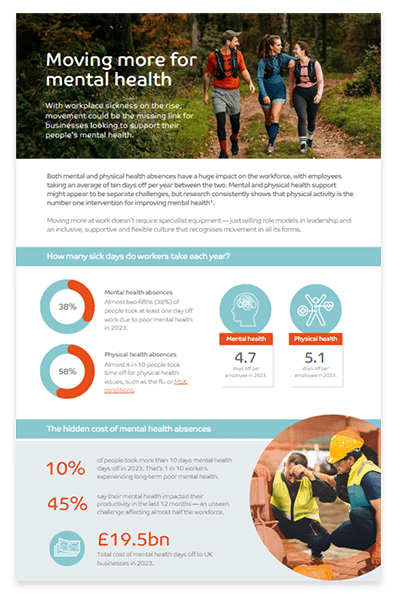The connection between mental and physical health is well documented, but its impact in the workplace is often overlooked.
Our yearly Workplace Wellbeing Survey found that almost two-fifths (38%) of people took at least one day off work due to poor mental health in 2023, while almost 6 in 10 (58%) took time off for physical health issues. These absences cost UK businesses around £19.5bn over the course of the year.
Mental and physical health are usually treated as two separate challenges, requiring different solutions, but research suggests that moving more is the most effective intervention when it comes to improving mental health.
How many sick days do workers take each year?
In 2023, employees took an average of 4.7 days off due to poor mental health and 5.1 days off due to poor physical health.
Workers take mental health days off for many reasons — from feeling tired or stressed, to prolonged mental health challenges such as generalised anxiety disorder (GAD) and depression. Physical health absences include everything from headaches and the flu to injuries and musculoskeletal issues.
Typically when people think of sick days, they think of a bad cold or stomach bug, but days off work due to depression, anxiety and stress are actually more common.
Additional hidden costs of employee absences
With employees taking around one working week off due to mental and physical health issues (two weeks when combined), the research suggests that absences rates are impacted similarly by mental and physical health — but the averages don’t tell the full story.

While the majority of physical health absences were short-lived, poor mental health resulted in more than 10 days of absence for 1 in 10 workers. That’s a significant impact on the workforce, not only in terms of individual poor health but also the knock-on effect of reduced capacity within the team — risking damage to morale and lower productivity.
Poor mental health in particular often comes with a hidden cost to businesses in the form of presenteeism. Our research found that 45% of UK workers say their mental health impacted their productivity in 2023 — but not all of them took time off because of it. The cost of this factor is difficult to measure, as employees may be physically present in the workplace but feel unable to work at their best.
Can sick days be avoided?
In short, sick days can’t be avoided. It’s normal for people to become ill and to need time out from work. Employee absences are an inevitable part of doing business, so the aim shouldn’t be to reduce sick days at all costs.
However, there’s a lot that business leaders, HR teams and people managers can do to better support workers’ wellbeing. Over a third (37%) of UK employees sought mental health advice last year, but with NHS demand at an all-time high, workplaces play a key role in providing preventative support.
Can movement unlock workers’ mental health?
Getting workers moving more could be key to creating a happier and more productive workplace — not just in terms of physical wellbeing, but mental health too. Instead of targeting mental and physical health in silo, it’s important to consider the symbiotic relationship between the two.
Moving more in the workplace doesn’t have to involve special equipment or big changes to the way you work. It just takes willing role models in leadership to drive a supportive, flexible and positive culture that encourages employees to take a bit of time out of their day to get moving.
For more research and ideas to help you use movement to support your people’s wellbeing, head to our new webpage: Moving more for mental health.
